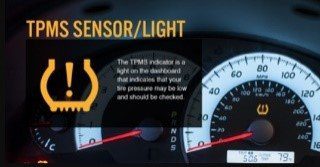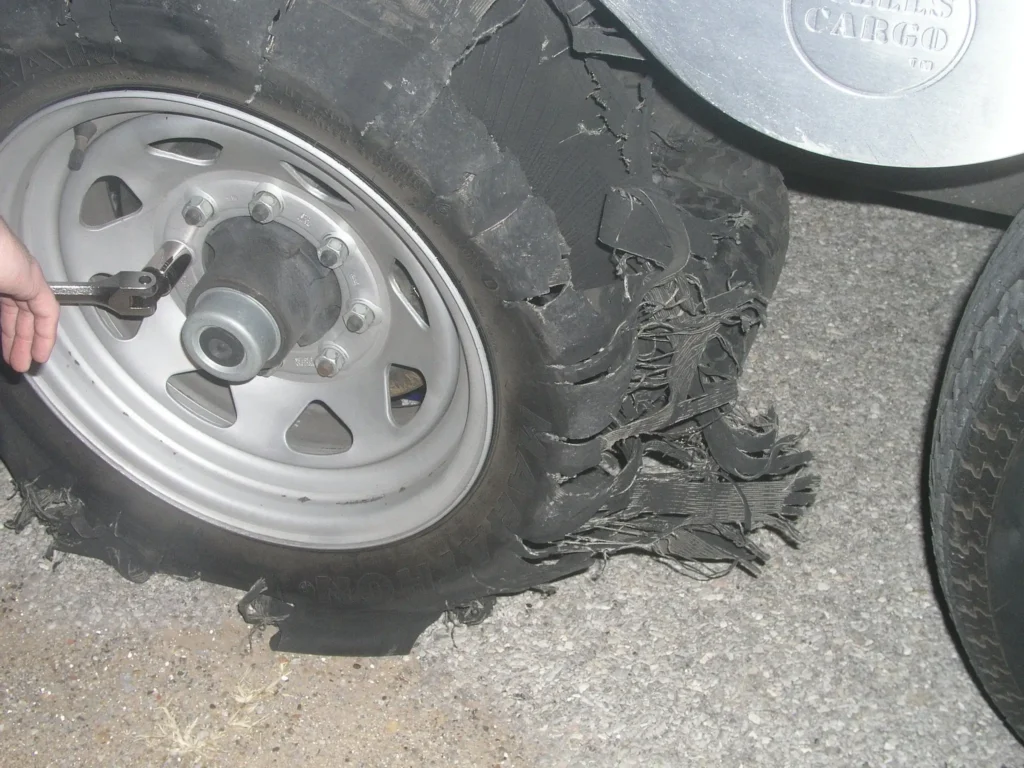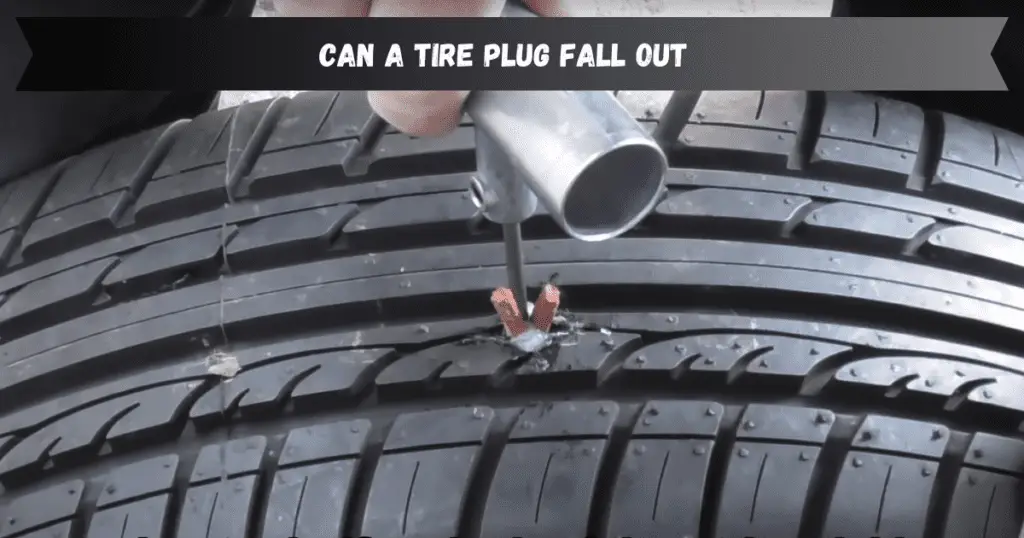Seeing your tire pressure monitoring system (TPMS) warning light come on can be worrying. But what if it’s not just illuminated steadily – what does it mean when the tire pressure light is flashing? Flashing and blinking TPMS lights can signal various issues that require attention.
How TPMS Works
Before diving into What Does It Mean When Tire Pressure Light is Flashing, let’s review how these systems work.
TPMS stands for Tire Pressure Monitoring System. It is designed to monitor the air pressure inside your tires and alert you if they become significantly under-inflated.
Each wheel is equipped with a tire pressure sensor mounted inside the tire. This sensor contains a battery, pressure transducer, transmitter, and an ID code that identifies it.
The sensor monitors the air pressure in real time and transmits this data via a radio frequency signal to a receiver module in the vehicle. The module passes the pressure information to the vehicle’s computer.
If the pressure in a tire drops 25% or more below the recommended level, the TPMS system will turn on the warning light on the dashboard to alert the driver. Most systems also display individual tire pressures on the vehicle’s information display.
What Does It Mean When Tire Pressure Light is Flashing? Maintaining proper inflation is critical for control, handling, tread life, and fuel economy. TPMS provides an important early warning of low pressure so it can be addressed before a blowout or other tire failure occurs.
What Does a Solid TPMS Light Indicate?
When the TPMS light comes on and remains steadily illuminated, it means:
- One or more tires are at least 25% below the recommended inflation level. For example, if the placard pressure is 35 PSI, the light activates at around 26-27 PSI or lower.
- The under-inflated tire(s) should be inspected and inflated to the proper placard pressure as soon as safely possible. Driving on severely underinflated tires can lead to damage.
- The light will extinguish automatically once the low tire(s) is reinflated. It may require driving a short distance to allow the sensors to transmit updated pressure data.
A solid TPMS light is the most common indicator of an underinflation issue that needs your attention. But sometimes this light can start blinking, which signals additional issues.
Why is the TPMS Light Blinking or Flashing?
What Does It Mean When Tire Pressure Light is Flashing? A blinking, flickering, or flashing TPMS/tire pressure warning light is trying to tell you that there is a problem with the TPMS system itself rather than just low tire pressure.
Typical causes of What Does It Mean When Tire Pressure Light is Flashing include:
TPMS Sensor Issues
Each wheel unit has a battery inside that powers the sensor. After 5-7 years, these batteries may become depleted or fail, causing sensor malfunctions. Dead batteries, failed transmitters, signal interference and faulty pressure readings can all cause blinking TPMS lights. Replacing the dead sensor will resolve this.
Incorrect Sensors
Installing the wrong sensor on a tire or mixing sensors between vehicles can confuse the TPMS module. It may not be able to properly identify the signal, causing the light to blink. Always replace sensors with new OEM-approved units.
Sensor Not Programmed
New TPMS sensors must be programmed or initialized on some vehicles so the control module recognizes their signals. If this relearn procedure is not done after new tires/sensors are installed, the light may blink due to unfamiliar sensor IDs.
Faulty Receiver
Issues with the TPMS receiver module like electrical failures, antenna, and wiring problems can prevent proper data reception, which manifests as a blinking light. The receiver may need replacement to restore function.
System Malfunction
General malfunctions in the tire pressure monitoring ECU, software glitches, and other system faults can also lead to blinking light behavior. Diagnostic trouble codes should point to the root cause. Software updates or TPMS controller replacement may be needed.
Low Battery Voltage
On some vehicles, the low battery voltage can affect TPMS operation and trigger an abnormal blinking light. Charging/replacing the battery resolves this once the voltage is restored.
Whenever the tire pressure warning light starts blinking or flashing instead of staying on steadily, it means the TPMS system needs diagnosing and repairing rather than just adding air to your tires.
How Long Does the Light Blink For?
When signaling a TPMS fault, the warning light generally blinks for around 60-90 seconds when the vehicle first starts, before remaining steadily illuminated. However, here are some other blinking durations to watch for:
- Light blinks for 5 seconds then stays solid – low tire pressure detected. Check inflation.
- Light blinks for 10 seconds then shuts off – may signal a minor issue or correction. Monitor function.
- Light blinks continuously – points to a TPMS malfunction. Requires diagnosis and repair.
- Light blinks in patterns (2 short, 1 long, etc.) – consult the owner’s manual for blink code details.
Blinking for up to a minute and a half upon startup is the most common TPMS fault indicator. What Does It Mean When Tire Pressure Light is Flashing? However, paying attention to exact blink patterns and durations can provide insight into the nature of the problem.
How Do You Fix a Blinking Tire Pressure Light?
When blinking or flashing tire pressure lights appear, here are the steps for correcting the problem:
1. Determine why the light is blinking – Use a TPMS diagnostic tool to pull fault codes and determine whether the issue is a bad sensor, programming error, receiver fault, ECU malfunction, etc.
2. Inspect sensors – Remove the wheels and thoroughly inspect sensor condition, age, mounting, seal condition, and battery status. Replace any damaged or dead sensors.
3. Relearn positions – Perform the TPMS relearn/programming procedure so the system recognizes the sensor IDs if new units are installed.
4. Update software – Update the TPMS control module software if needed to address any bugs causing erratic light behavior.
5. Test system – Clear codes and test drive the vehicle to see if the blinking light is resolved after repairs, programming, and software updates are complete.
6. Further diagnosis – If the light continues blinking, further system diagnosis and testing are required to pinpoint the fault. Receiver modules, ECUs, and wiring may need replacement.
Fixing a blinking TPMS light requires identifying the root cause and then replacing the malfunctioning component – whether that’s a dead sensor, faulty controller, software bug, or electrical issue. This will restore normal system operation and steady warning light illumination.
Why is the TPMS Light On but Tires are Full?
Sometimes the TPMS light remains on solidly even after inspecting the tires and confirming they are all properly inflated. Common reasons this can happen include:

Sensor issues – A failed sensor battery, transmitter glitch, or signal interference can give false low-pressure readings, triggering the warning light.
Incorrect placard pressure – Setting pressure based on the wrong specs (like sidewall rather than door placard) will seem full but the light stays on.
Normal pressure fluctuations – Changes from temperature drops or elevation changes may activate the light before acclimating.
Sensor relearning – Sensors may need to be relearned after rotation, replacement, or system work before reporting correct pressures.
System fault – Electrical gremlins, receiver failures, and ECU bugs can also cause improper light operation and activation.
Tire integrity – A slow leak, hidden puncture, or other damage may be reducing internal air volume over time while allowing pressure to seem normal.
What Does It Mean When Tire Pressure Light is Flashing? If you’ve verified placard pressures but the light persists, TPMS faults should be investigated through diagnostic scanning and sensor testing. Repairs will likely be needed to restore accurate monitoring. Don’t ignore the warning.
What Does Low Tire Pressure Feel Like When Driving?
Low tire pressures affect handling, ride quality, braking distances, and traction. Some symptoms you may notice include:
- Vehicle pulling to one side – Indicates one side is lower than the other.
- Reduced responsiveness and sluggish turning
- Excessive bouncing and impact harshness
- Longer braking distances and reduced grip
- Reduced fuel economy – Underinflated tires create more rolling resistance.
- Excess shoulder and center tread wear from overheating.
- Excess vibration and wander at highway speeds
- Wheel rim damage from tires flexing when aired down.
Don’t wait to feel symptoms before checking pressures. What Does It Mean When Tire Pressure Light is Flashing? Address TPMS warnings promptly to avoid handling issues, wear problems, and blowout risks.
How Serious is the TPMS Light – Should You Stop Driving?
- If the light is on solid, you do not need to immediately pull over. The 25% underinflation that activates the light is not an emergency if you maintain an appropriate speed and drive carefully a short distance to a safe place to add air. However, severe underinflation should be addressed ASAP.
- If the light is blinking, you can generally safely drive to an auto repair shop as long as the vehicle seems to be handling normally. Flashing lights indicate a fault with the TPMS itself rather than unsafe tire pressures. Use caution and avoid excessive speeds.
- If you notice severe handling, stability, or vibration issues, get off the road safely right away, whether the light is on or not. Significantly underinflated or damaged tires can indicate an emergency. Call for roadside assistance if needed.
What Does It Mean When Tire Pressure Light is Flashing?While the TPMS light aims to provide early warning well before emergency levels, do not hesitate to stop driving immediately if you notice adverse symptoms of extremely underinflated or failing tires. When in doubt, err on the side of safety.
Conclusion – What Does It Mean When Tire Pressure Light is Flashing
When that tire pressure warning light switches over from illuminated solid to blinking or flashing, it means there is a problem with the TPMS system itself rather than just under-inflated tires. Diagnosing and repairing faulty sensors, controllers, wiring or software is key to restoring proper monitoring and steady light operation. Don’t ignore blinking TPMS warning lights – this abnormal operation is trying to tell you something needs professional attention for optimum safety and performance.





